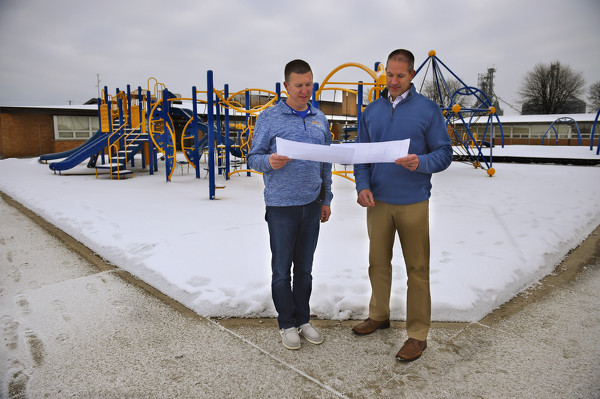Friday, January 29th, 2021
County home closing
Closure set for June; demo will follow by year's end
By Leslie Gartrell

File Photo/The Daily Standard
The Mercer County Home, shown in this file photo, is set to close following action Thursday by Mercer County Commissioners to shutter the facility and then raze the building by the end of the year. Nine residents live there.
CELINA - The Mercer County Home, one of the last county homes in the state, is set to close in June and be demolished by the end of the year.
Mercer County commissioners on Thursday approved a resolution to close and eventually raze the building. A report from the commissioners cite a lack of residents, inadequate facilities and cost-prohibitive renovations as reasons for the closure.
Built in 1860, the facility was designated as a custodial-care facility for less fortunate residents in the county. The facility was originally funded through the county general fund and has always been under the control of the county commissioners, according to the report.
Most counties had an operational county home in the 1900s but the majority have since closed. The Mercer County Home is one of only eight county homes still in operation in Ohio.
The number of residents has waned over the years, from 34 in 1994 to 22 in 2004 and an average of 12 residents in 2020. As of Thursday, only nine residents were staying in the home.
Commissioners said the availability of other federal- and state-funded programs have expanded, and other local agencies such as nursing homes have expanded and now serve the same clientele as the county home.
The home typically serves people who cannot live on their own without some level of daily or hourly support. However, it also is a non-certified care facility due to its design and lack of licensed medical staff.
Because it's not a licensed care facility, the home is not eligible for Medicaid or Medicare funding, Optional State Supplementation Payments or Supplemental Social Security payments of behalf of the residents.
The facility also is not suited for people who need extensive medical care, according to the report. With small individual rooms, group bathrooms and limited handicapped accessibility, the current building doesn't easily serve the needs of residents today.
"The facility doesn't meet the current needs for elder care," commissioner Greg Homan said on Thursday. "Those limitations become more burdensome over time."
The county commissioners met with officials from Mercer County Job and Family Services, Mercer County Board of Developmental Disabilities and Foundations Behavioral Health Services to determine if current residents could be served by other agencies if the home discontinued operations, Homan said.
The group evaluated the nine residents and determined four are capable of living self-sufficiently. They will be provided with job training and relocation assistance to private residency apartments with support from MCJFS.
Five residents will be assisted in transitioning to assisted-care facilities with support from Adult Protective Services, Mercer DD and Foundations.
Homan said the 2021 budget for the facility includes the cost of transitioning residents to other facilities and alternate residency options.
The home currently has three part-time and eight full-time resident care employees and a full-time administrator. The administrator and two of the resident care employees are eligible for retirement, according to the report.
Employees will be provided with a temporary extension of health insurance and assistance from MCJFS to help transition to new employment.
The home has been financed through a five-year levy since it was introduced in 2004. It's been strongly supported over the years and was renewed in 2009, 2014 and in 2019.
The levy is the main source of the home's funding, although residents who are able to pay for a portion of their expenses do so.
The levy brought in $775,381 in tax income in 2020, according to the report. County home residents who paid room and board fees provided a total of $27,811 in 2020.
Voters renewed the levy to operate from Jan. 1, 2020 until Dec. 31, 2024. However, county commissioner Jerry Laffin said the levy will only continue to collect until the end of this year. The levy is expected to bring in roughly $775,000 in 2021.
The home's average expenses from 2018-2020 is approximately $814,837 per year, with major expenses including staff salaries and benefits, supplies and other building expenses.
Based on the facility's current operating expenses and only nine residents staying there, the current annual cost per resident in 2021 would be roughly $90,000 per year, according to the report.
Commissioners said they believe asking Mercer County residents to continue to renew a property tax levy that can't provide the resources or renovations necessary to keep the facility operational would not make sense.
"The age of the building and lack of design to meet modern accessibility and health care needs would likely require even more resources than the existing levy provides," the report reads.
Not only would the financial cost to convert the home into a licensed nursing home be cost prohibitive, the report continues, but also the Mercer County government doesn't want to "compete" with local businesses such as nursing care facilities and group homes that can service the clients that are Medicaid eligible.
According to the report's time table, residents will be transitioned to their respective residency options throughout February through and May. The anticipated closing date for the home is June 30, and the building will be demolished sometime this fall or winter.
Removing the building is anticipated to cost roughly $400,000, according to the report. Overall expenses, including the building removal, resident transition costs, employee unemployment, utilities, salaries and benefits and more is expected to cost nearly $1.4 million.
Homan said the commissioners had yet to finalize what will be done with the site. The property has one suitable storage barn that could be utilized for county storage, he said.











